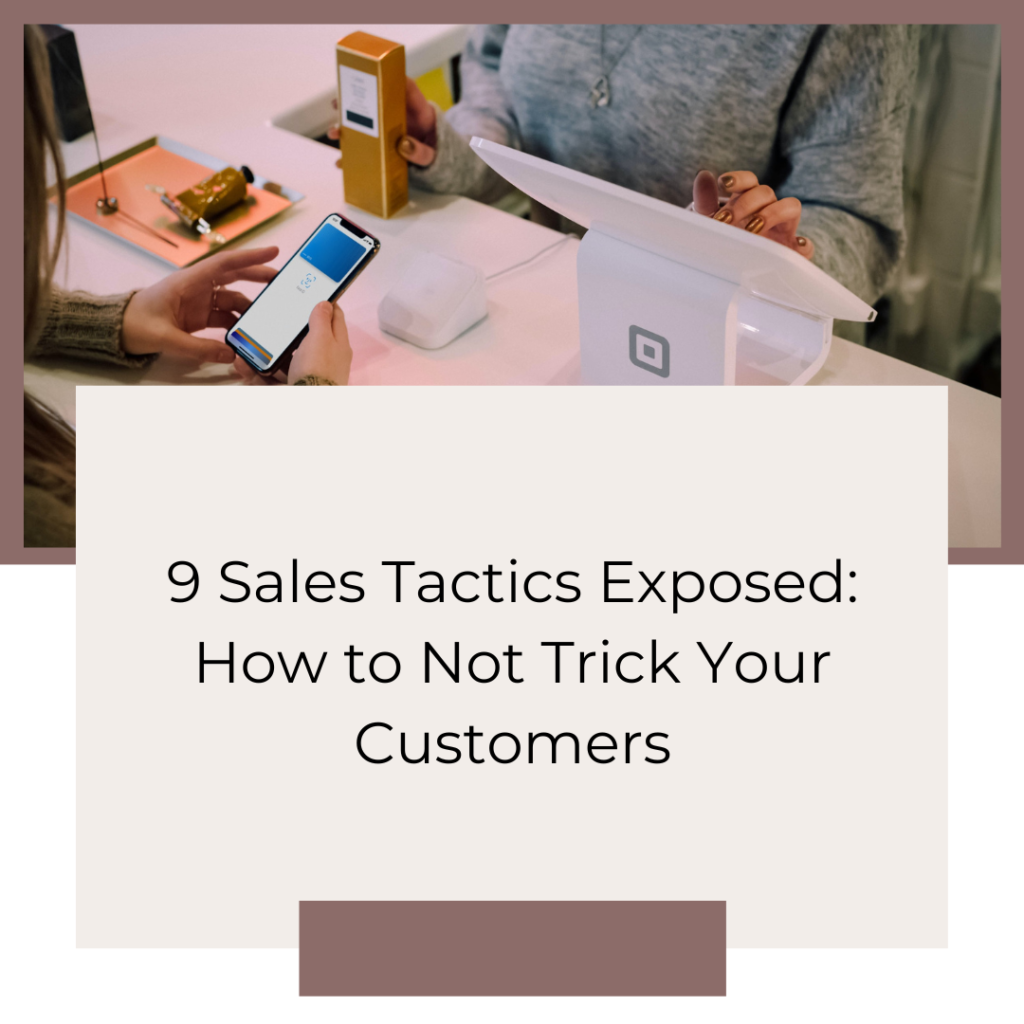9 Sales Tactics Exposed - How to Not Trick Your Customers

Using sales tactics in your marketing can elevate your business and increase revenue. But they can also be detrimental for long term success. We’re exposing 9 sales tactics that will get you those sales, without compromising customer relationships.
What is tactical selling?
Tactical selling, or sales tactics, are psychological tricks and techniques used to convince potential customers to buy your products.
Sales tactics, or tricks, are often viewed as negative from a customer perspective. The word ‘tricks’ implies that you are being fooled. But there are plenty of ways to incorporate sales tactics without being unethical and tricking your customers. This article will cover 9 sales tactics and how to implement them for the long term success of your business.
The article includes:
Sales tactics as marketing
You might think of sales as a separate entity from marketing. Because they are usually divided into different units in corporations. But sales is part of marketing. The purpose of both marketing and sales is to sell more right? While many large corporations treat these units separately, it is vital for you to combine them. Including sales tactics in your marketing can convert unsure customers into actual customers.
The risk of sales tactics
We all know the annoying feeling when a sales person tries to push you to buy something you have no interest in. If you, despite your own will, find that you bought the product. Then you will come home feeling fooled and dissatisfied with the purchase. That is the perfect example of when sales tactics have been used incorrectly. And this does not contribute to the long term success of the business. The risk of using sales tactics is that it can harm the reputation of the business, if used for the wrong reason. Consumers do not want to feel like they have been tricked into buying something. They will feel bad after the purchase and not buy from that business again. It is also likely that the person will share their negative experience with friends and family. Thus contributing to the business’s bad reputation.
Good sales, instead, finds the people that actually have a need for the product. Then presents the solution the customer has been searching for. That is the purpose of both marketing and sales. Helping the people who needs the product, to find and buy it.
The sales tactics in this article are not meant to trick customers into buying your products. They should be incorporated in your marketing messages. And get hesitant customers to complete their purchase.
Sales vs. customer orientation
Sales tactics does not consider what happens after a customer has completed a purchase. The single goal of sales tactics are to complete the sale. A sales orientation in your business can thus be detrimental for long term success.
On the other end of the spectrum there is customer orientation, which means to always put the customer first. However, this can also have negative consequences for your business. If you only consider the customer’s best and disregard sales goals. It is vital to consider the customer’s satisfaction along with the sales goals to achieve business success.
You should therefore use the sales tactics provided in this article in combination with a customer orientation. Thus, ensuring that you make sales while also building long term customer relationships.
9 sales tactics to grow your business
Using sales tactics for the right reasons can contribute massively to your short term as well as long term success. Now let’s look at the 9 sales tactics you can use, without compromising your customer relationships.
Sales tactics 1: The blow below the belt
The blow below the belt sales tactic involves offering the customer a great deal that is difficult to say no to. After offering the deal you incorporate a short wait time. Then you reveal that the deal might not be as good as the customer first thought. The customer has then gotten accustomed to the idea of buying the product. Therefore, they will continue with the purchase despite the changes.
How to use it
When using this sales tactic it is vital to ensure that the customer does not feel tricked. The key to using the blow below the belt is to provide honest information and still offer the customer a good deal. In addition, you need to provide after-purchase care to ensure the customer’s satisfaction.
An example is to offer a great deal in an ad campaign for a product. This attracts the customer’s attention and makes them want to buy the product. The customer then has to sign up for the product in advance, for example for a product release. After a short wait time you release the product. And then provide the necessary information to ensure that the customer still wants to buy the product. Despite the initial offer seeming better.
It is important that you provide the same value you offered in the first ad, even if there are added contingencies.
Sales tactics 2: The foot in the door
The foot in the door involves getting to yes through small steps. It means to get the customer to say yes many times during communications with them. Until they finally say yes to the ‘big decision’. You start by asking short, easy questions that the customer has to say yes to. When they have said yes that many times, they will ultimately say yes to the purchase as well.
How to use it
This sales tactic is about knowing your customer and identifying their problems and needs. You want to ask questions that the customer identifies with and gets that ‘yes, that’s me’ feeling from. Evoking that feeling many times makes the customer engaged. When you then offer your product as the solution you are not ‘tricking’ them into buying your product. They truly want to buy your product. To understand your customer and know what questions to ask them you need to have a target audience. Check out this article on Target Market Analysis to learn how to identify your target audience.
Engaging with potential customers by asking them questions does not need to be through traditional face-to-face conversations. You can also use social media to ask questions. For example through stories with engagement stickers. If you want to learn more about how to use social media for your marketing, read this article on Small Business Social Media Marketing.
Sales tactic 3: Fall back but do not give up
The third sales tactic involves the seller giving many times over, then falling back, making the customer want to repay the favor. This is more often used in personal or direct sales, and can be viewed more as a negotiation tactic. For example a sales person will offer a bad deal that is in the seller’s favor, which the customer says no to. Then the customer makes a counter offer, giving in to some of the seller’s wishes. The seller falls back and seemingly gives in to the customer’s demands. But this was the plan all along and the seller thus gets many of their points across.
How to use it
This sales tactic is easier to use in B2B industries, but it can be used in marketing to consumers as well. For example it can be used to retarget customers. Maybe you have a potential customer that has signed up for your newsletter. Or previous customer that has left items in the basket on your website. Then, you can use this strategy to get the customer interested in your offer again. By first reminding them of your offer and if they don’t go through with the purchase, then offer a personal discount.
Sales tactic 4: Others do it too
The sales tactics others do it too is based on social proof; people do what other people do. Consumers rely on that people around them know how to think, feel and act. And they then follow their lead. This sales tactic thus uses the power of peer pressure. If a customer knows that many other people bought the same product, they will feel less unsure of their purchase.
How to use it
Other do it too is often used by ecommerce stores that shows how many people are looking at the same product as you. Or how many people bought that product within a certain time span. Testimonials and reviews are also ways of portraying social proof that helps sell more products. Another way to use it in physical stores is by creating lines to enter the store. This attracts more people to the store and they get more inclined to enter. However, it is important not to create too long lines discouraging people to enter.
Sales tactic 5: Eye for eye
The eye for eye sales tactic builds on the principle of reciprocity. The seller gives so many times that the buyer later feels the need to give back.
How to use it
An example of this tactic is to offer free information on social media, newsletters or free downloads and guides. After offering value for free to the customer during multiple occasions, the customer will feel the need to reciprocate. When the seller finally asks for something in return for all this free value, such as money for a product, the customer will say yes.
Sales tactic 6: If you like me, you like my product
Customers are more inclined to buy a product from someone they like. Because liking build trust. There are three ways to create liking. First is to create a common enemy, which creates a temporary friendship. We all know the saying ‘the enemy of my enemy is my friend’ right? The second way to create liking is by forming similarities. That means to find similarities between yourself and the customer, such as interests, background etc. This is because people like other that are like them. The third way to create liking is by expressing liking towards the customer. Such as complimenting them on their looks or actions.
How to use it
To use this sales tactic you need to expose more of yourself as a seller or as a brand. Using your personal brand for this sales tactic enables people to get to know you and identify with you. Thus forming liking. But it is also possible to use your business’ brand to create liking. You then have to make sure that you have a clear brand personality that customers like and can identify with. If you want to learn more about branding you should check out this article on How to build a brand. After creating a clear and likable brand, you can use social media to create liking. Post stories or posts with similarities you/your brand has with your customers. Or you can complain about a topic, creating a common enemy.
Sales tactic 7: You like my product if it’s connected with other things you like
Similar to sales tactic 6, people will like your product if it is exposed together with something else that they like. The classic example is a sports car that is shot together with a hot woman. Say what you want about it being sexist, but it works.
How to use it
To use this sales tactic you simply expose the product you are selling in a context with other things the customer likes. Such as in an image/video for an ad or in a social media post. The key is to identify what your customers like. What are their interests, hobbies and preferences? A great way to identify these elements is to create a customer profile, which also helps keep your target customer in mind when creating sales messages. You can learn how to create a customer profile here. Once you have identified your target customer’s likes it will be easier finding which of these likes you can include in a your marketing.
Sales tactic 8: Scarcity is valuable
The scarcity is valuable sales tactic involves signaling scarcity, making customers feel pressured to buy the product. Scarcity increases perceived value of the product in several ways. When a product is scarce the assumed cost and quality increases, which makes the product seem more valuable to the customer. The status of the product is also perceived as higher and customers are more likely to appreciate the product and feel like it is a good investment. When a product is scare it can also require more effort to buy it. When there is limited availability people might have to que for the product or look for it for longer, which increases the level of effort required to get it. This also increases the perceived value.
How to use it
Scarcity is a common sales tactic that is used in marketing very often. It can be an offer that is available for a limited time, such as a sale or reduced price. Or it can be a product that is only available for a limited time or quantity, such as a limited edition. You can thus use scarcity in all industries across all types of sales platforms.
Sales tactic 9: Authority knows best
Authority knows best is a sales tactic based on people deferring to authority. When people are in contact with authorities, they automatically listen and believing the authority says something valuable and true. This also applies in sales. By using a person with authority in your industry or by referring to yourself as an authority, customers will listen to you.
How to use it
Authority can be used in sales by either referring to a professional within the industry. Such as a doctor recommending a certain type of medication. Or a personal trainer recommending a fitness routine. But the authority referred to in your marketing can also be yourself or your business. In the latter case it is again important to build your brand as an authority in the field. That will make your potential customers trust you/your business and will make them inclined to listen to your sales offers.
And there we have it! The 9 sales tactics that will increase your sales and help grow your business:
- The blow below the belt
- The foot in the door
- Fall back but do not give up
- Others do it too
- Eye for eye
- If you like me, you like my product
- You like my product if it’s connected with other things you like
- Scarcity is valuable
- Authority knows best
If you enjoyed this article please share it with a friend or coworker that should read it!

I'm Emma Ellinor
I’m a digital marketer, project manager and retail analyst.
For the past 7 years I have immersed myself into the field of marketing and management. I am on a mission to inspire more women to take their business to the next level. By sharing my journey to escape the 9-5 trap along with useful marketing, time management and small business tips.
